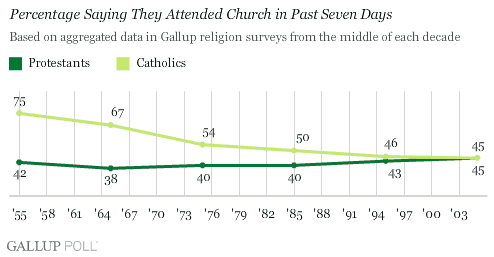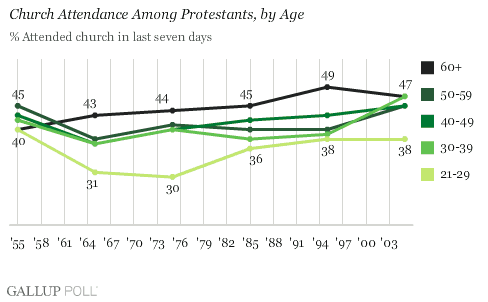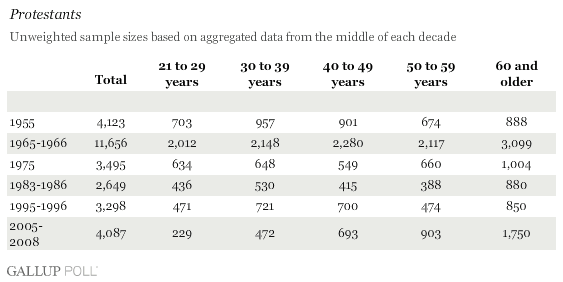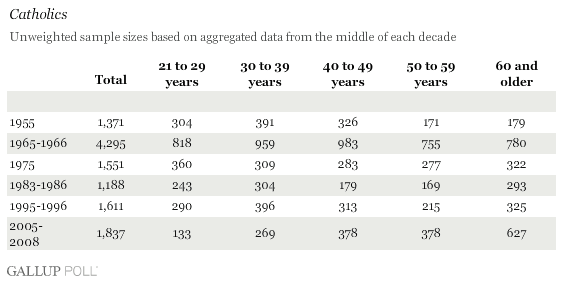PRINCETON, NJ -- According to Gallup Poll trends on church attendance among American Christians, weekly attendance among Protestants has been fairly steady over the past six decades, averaging 42% in 1955 versus 45% in the middle of the current decade. However, attendance among Roman Catholics dropped from 75% to 45% over the same period.

Most of the decline in church attendance among American Catholics occurred in the earlier decades, between 1955 and 1975; however, it continued at a rate of four percentage points a decade through the mid-1990s, and church attendance has since leveled off at 45%.
The Gallup Poll's rich archives of religious preference and church attendance data have been mined in time to provide a detailed picture of church attendance trends among U.S. Christians heading into Easter Sunday. Multiple surveys were combined for each decade starting with the 1950s, using Gallup religion surveys conducted closest to the middle of the decade. This provides ample sample size to examine the church attendance patterns of Protestants and Catholics, and of various age categories within those religious groups.
On the basis of these 10-year snapshots of church attendance, the percentage of Catholics saying they went to church in the past week is essentially unchanged between 1995 and today. That's an extremely important finding given the upheaval in the U.S. Roman Catholic Church caused by the sexual abuse scandals that erupted earlier this decade. Gallup polling in 2002 and 2003 found a decline in the percentages of Catholics saying they had attended church in the past week; however, attendance rebounded by the end of 2003 and has since remained on par with its pre-scandal level of about 45%.

Young Catholics Drop Out of Church by the 1970s
Beyond the divergent attendance trends of Protestants and Catholics, the historical data reveal distinct generational patterns in church attendance within each Christian faith.
In 1955, adult Catholics of all ages attended church at similar rates, with between 73% and 77% saying they attended in the past week. By the mid-1960s, weekly attendance of young Catholics (those 21 to 29 years of age) started to wane, falling to 56%, while attendance among other age groups dropped only slightly, to around 70%. By the mid-1970s, only 35% of Catholics in their 20s said they had attended in the past week, but attendance was also starting to fall among those in their 30s, 40s, and 50s.
Attendance for most of the groups continued to fall from the 1970s to the 1990s. However, over the past decade it has generally stabilized, particularly among Catholics in their 20s and 30s.
Across this entire period, attendance among Catholics aged 60 and older has dropped from 73% to 58%.

Protestant Attendance Steady Among Most Age Groups
The picture in attendance by age is entirely different among Protestants. Apart from a temporary dip in weekly church attendance among 21- to 29-year-old Protestants in the 1960s and 1970s, attendance has stayed the same or increased among all the age groups. It even rebounded among young Protestants in the 1980s, and is now close to 1950s levels.

Of course, the "Protestant" moniker encompasses many distinct religious denominations, some of which have reportedly experienced high growth in membership over the past few decades, while others have been in decline. The figures reported here represent averages for all Protestant faiths.
Bottom Line
The increasingly spare attendance at regular mass has been of considerable concern to the Catholic Church in the United States for some time. Theologians and other observers have variously offered the cultural upheaval of the 1960s, changes to the church brought about in the 1960s by the Second Vatican Council, and national publicity in 2002 over sexual abuse lawsuits against Catholic priests as possible contributors to the trend.
Whatever the causes, it is clear that U.S. Catholics' once-nearly uniform obedience to their church's requirement of weekly mass attendance has faded, and Catholics are now no different from Protestants in their likelihood to attend church. This has occurred among Catholics of all age categories, but is most pronounced among those under 60. The good news for the Catholic Church is that the drop in attendance seems to have slowed or abated altogether in the last decade, spanning a most difficult period for the church around 2002, when attendance did suffer temporarily.
U.S. Protestant church attendance has also been steady over the past decade, but is actually higher now than it was in the 1970s and 1980s, in part the result of a resurgence of regular attendance among young adults.
Survey Methods
These results are based on aggregates of Gallup Poll surveys for the following periods: 1955, 1965-1966, 1975, 1983-1986, 1995-1996, 2005-2008. The sample sizes for Protestants and Catholics, overall and by age group, are provided in the accompanying tables.


